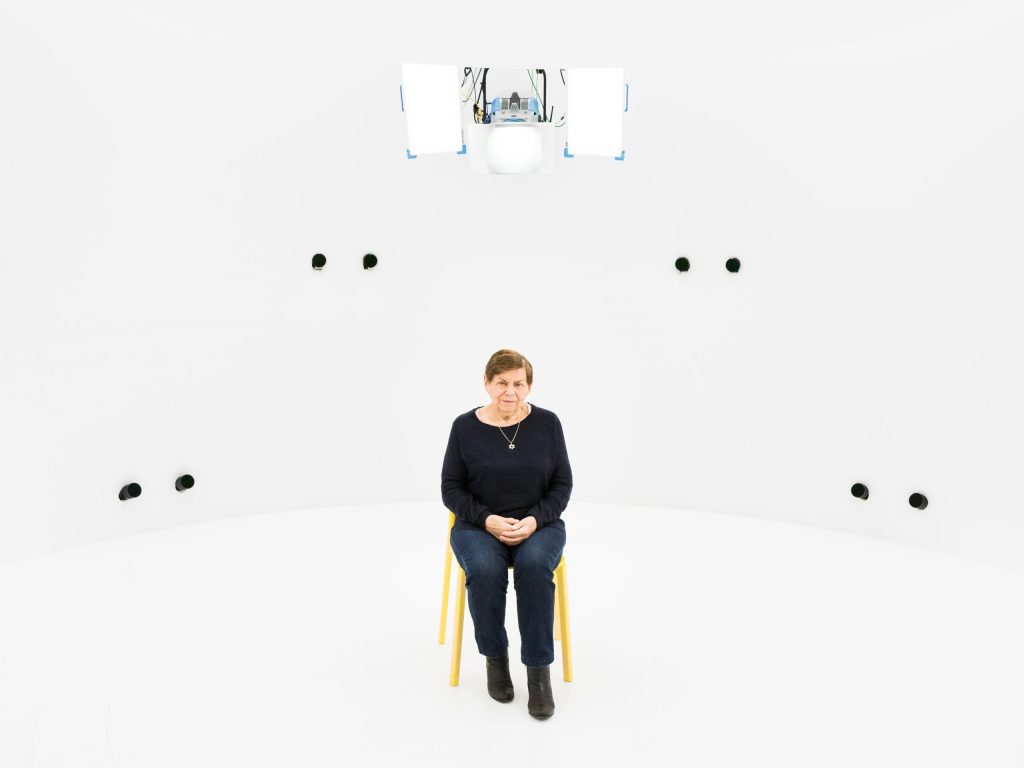The VR project “For real – virtual encounters with contemporary witnesses of National Socialism”
When Holocaust survivors talk about their experiences, they often do so at events, at the invitation of schools or in front of TV cameras. However, more than 78 years after the end of the Nazi regime, there are fewer and fewer eyewitnesses who can give us first-hand accounts of the horrors. The question is not only for historians: how do we convey to the younger generations what happened back then and must not happen again? Immersive media such as virtual or augmented reality applications offer an opportunity to approach the culture of remembrance in a new way. One particular project, which can be viewed at various locations in Brandenburg from the end of August, is “In Echt? – Virtuelle Begegnung mit NS-Zeitzeug:innen” (In Real? – Virtual Encounters with Nazi Eyewitnesses) – created through a cooperation between the Brandenburg Society for Culture and History (BGK) and the Film University Babelsberg KONRAD WOLF and financed with funds from the Foundation EVZ – Remembrance, Responsibility and Future. Volucap was commissioned for the technical processing, rendering and data management. The volumetric raw data of the interviews had already been recorded there in a previous project.
“In Echt…?” is a nationwide pilot project that will hopefully also have points of reference in an international context. After all, the problem of flaring anti-Semitism, racism and xenophobia is not a specifically Brandenburg (or German) problem. Hearing and seeing authentic contemporary witnesses here, who tell their traumatic experiences first-hand, is a very essential approach to a personal experience of historical events. However, when these contemporary witnesses are no longer around, it is all the more important to retain the “liveliness” of their stories,” explains Dr. Katalin Krasznahorkai, Curatorial Director, Brandenburg Society for Culture and History.
Volumetric interviews with contemporary witnesses
Holocaust witnesses such as Inge Auerbacher, Leon Weintraub, Ruth Winkelmann, Kurt Hillmann and Charlotte Knobloch, all in their 80s and 90s, traveled to Babelsberg in 2021 to be interviewed. They themselves had a completely new experience: placed in Volucap’s volumetric studio in a white dome, equipped with numerous cameras. Documentary film director Christian Zipfel, who artistically and conceptually supervised the project on behalf of the Film University, interviewed them. He had a limited recording time of around one hour to capture the essential aspects of their life stories. Unlike TV documentaries, where the interviewees talk for several hours and an interview is edited from the material, here the life stories had to concentrate on the essentials.
This was due to the enormous amounts of data required for the volumetric recordings. Sven Bliedung von der Heide, CEO of Volucap, explains in an interview: “The resolution of our studio is world-leading, we can record at 3,000 megapixels. That’s an immense amount of data. Storing and processing around five minutes of material is comparable to the amount of data in all the books in the world. This data not only needs to be stored, but also processed.” This is also a challenge for the Volucap team, whose volumetric systems tend to contribute sequences of several minutes for films, video clips or games.
A new approach to cultures of remembrance
The aesthetics of the narrative are also different. In the later VR application, the white space of the studio is retained. “It was important to us that the filming situation remains transparent from a documentary point of view,” says Professor Björn Stockleben, project manager of “In Echt?” at the Film University. “In the previous project, we worked with elaborately digitally reconstructed locations in Theresienstadt in order to visually contextualize the accounts of contemporary witness Margot Friedländer. This time, we are focusing on the immediate presence of the narrator and therefore placing the volumetric shots alone at the center.”
The Film University team also developed the corresponding VR application. In order to do justice to the interview content and at the same time be able to offer important excerpts, pupils from the 9th grade of the Voltaireschule in Potsdam were asked to evaluate transcripts of the interviews in a workshop and select the most emotional, exciting and important parts for them. Young people are one of the project’s most important target groups. “It was very exciting to see how media-sensitive the students were and how thoughtfully they dealt with the technical possibilities and the complexity of the topic,” reports Dr. Katalin Krasznahorkai.
Thanks to video games and the omnipresence of smartphones, they are used to different media consumption. “We still know the contemporary witnesses from two-dimensional television. A presentation that seems old-fashioned in this day and age. With VR glasses, there is much more interaction. You have the feeling that the person is standing in front of you,” adds Bliedung von der Heide from Volucap. However, it was important to everyone involved that the technology did not distract from the stories of the Holocaust survivors. “Communicating the topic is the most important task – not the claim to be as immersive as possible in the media,” confirms director Christian Zipfel.
The exhibition “For real?”
From the end of August, the photographs will be shown in the “In Echt?” exhibition at various locations in Brandenburg, including Potsdam, Wittstock/Dosse, Kyritz, Pritzwalk, Jüterborg, Cottbus and Finsterwalde. Together with an agency, the Brandenburg Society for Culture has created an accompanying exhibition that offers a wealth of additional information. It is particularly important to them to offer access to this format and virtual encounters with contemporary witnesses to National Socialism in regional and rural locations beyond the big cities, where it is urgently needed.
In the exhibition, visitors use VR glasses to enter the digital space in which ten questions float before their eyes. In chronological order, they range from the November pogroms to an outlook on right-wing tendencies today, including the AFD. Individual questions can be selected by eye control. In the next step, the interface disappears and you are confronted with a lifelike scan of one of the five Holocaust witnesses, who gives a pre-recorded subjective answer. In the application, you meet the people several times in response to different questions – this is also important in order to build up a certain bond with the people portrayed and not to consume an unmanageable number of interview parts, says director Zipfel.
In addition to the current exhibition, which opens on August 29 at the House of Brandenburg-Prussian History in Potsdam, an extensive archive of contemporary witnesses has been created. “How do pupils, students, multipliers or even just passing visitors react to this opportunity to engage with contemporary witnesses and their stories in VR glasses?” is one of the questions we will be asking over the coming months, says Dr. Katalin Krasznahorkai. On behalf of the BGK, the Film University is supporting the scientific evaluation of the project and how the culture of remembrance is changing in the way it is communicated and how the experiences of contemporary witnesses can be kept alive for future generations.
Image Credit: Contemporary witness in the Volucap © Filmuniversität Babelsberg KONRAD WOLF, Photo: Jakob Grasböck
More about the MTH Blog
The media technologies of the future are already being used today – not only in the entertainment sector but in a wide variety of industries. For our MediaTech Hub Potsdam blog, we talk to tech enthusiasts, entrepreneurs and researchers once a month and tell the stories behind their innovative business models, ideas, projects and collaborations.



